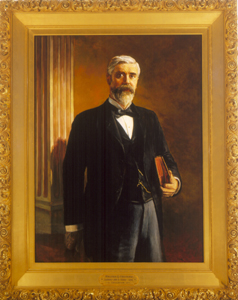Upon the death of Secretary of the Treasury Charles J. Folger in September 1884, Walter Q. Gresham (1832 - 1895) accepted President Arthur's stopgap appointment as Secretary. Gresham, previously Arthur's Postmaster General, had been close to Folger and shared his ideas on finance. The overriding question was what to do with the Treasury's surplus, an issue unresolved during Folger's tenure. Gresham agreed with Folger's suggestion that the surplus should be reduced by a cut in Customs duties. He stated that ''public credit has been so firmly established and the public debt so largely reduced that we can now safely reduce taxation within the demands of the law."

Sec. Walter Q. Gresham
Charles Harold L. MacDonald
Oil on canvas
1893
69 1/4 x 56 1/4 x 4 3/4"
P.1893.12
A believer in sound money, Gresham told New York businessmen that the only way to keep government currency afloat as legal tender was for the Government to keep enough gold in the Treasury to meet the demand of notes presented. Gresham resigned after two months to become Circuit Judge of the Seventh Judicial District.
About the Artist
Born in Manitowoc, Wisconsin in 1861, Charles Harold L. MacDonald (1861 - 1923) traveled as a young man to Paris to study painting with Gustave Boulanger and Jules Lefebvre. He moved to Washington, D.C. in 1890 and began a portrait business, filling many commissions for the Federal Government. In addition to painting Walter Gresham, MacDonald painted the Treasury Collection portraits of Secretaries Dexter, Windham, Gage, and Cortelyou. His portrait of Gresham, painted in 1893, is thought to be painted from life.
